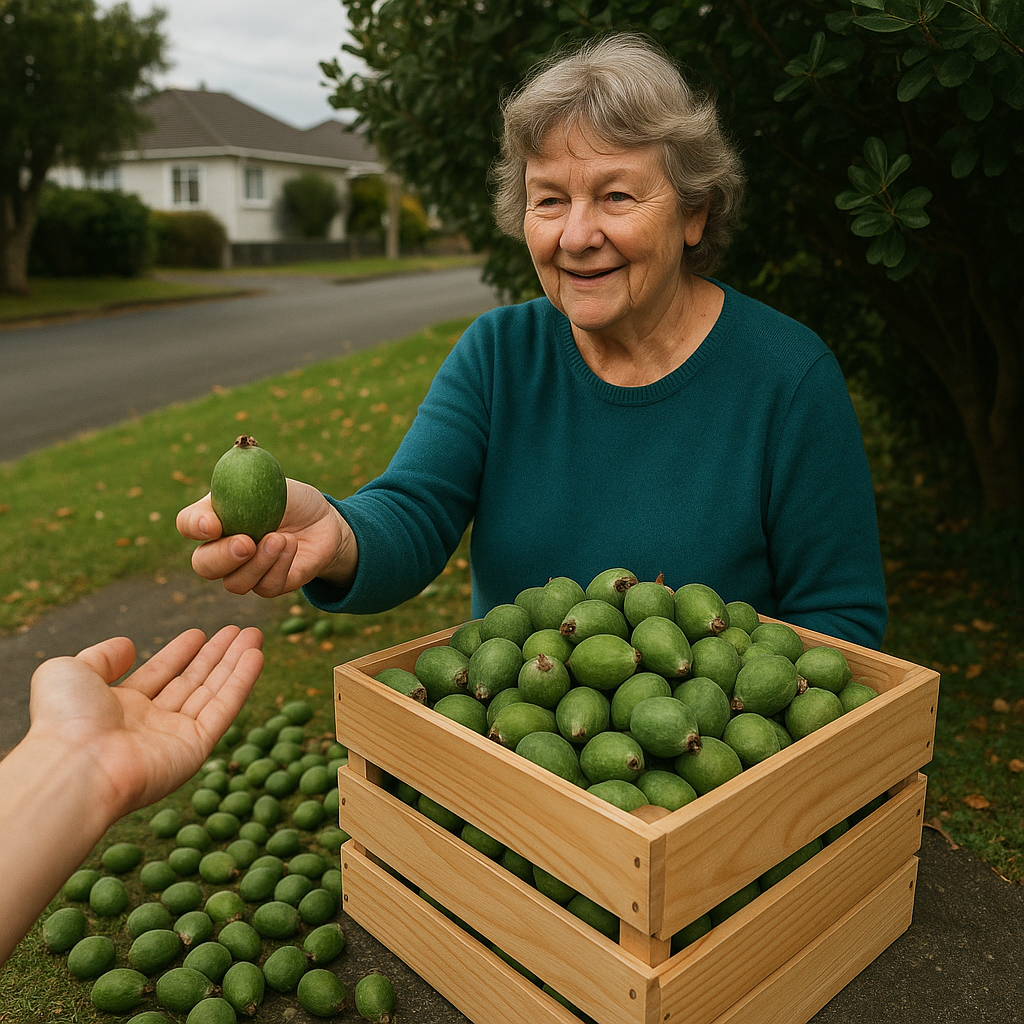In New Zealand, people love a fruit called feijoa, even though it originally comes from South America. Unlike the kiwi fruit, which is famous worldwide, feijoas are not sold much outside New Zealand because they don’t stay fresh for long. Every year, when feijoas are ripe, New Zealanders get very excited about eating them. They feel a special connection to this fruit.
Feijoas are often shared with friends and neighbors. In autumn, feijoa trees drop their fruit, and people collect them to give away for free. Many people in New Zealand never have to buy feijoas because they are shared so freely. This sharing creates a strong sense of community and kindness among people.
Not everyone likes the taste of feijoas; some people love it, while others do not. For New Zealanders living in other countries, feijoas remind them of home and childhood. Even though there are attempts to make feijoas last longer for selling abroad, they remain a special part of New Zealand’s autumn. The fruit brings people together and is an important tradition in the country.
Original news source: New Zealand’s unofficial fruit is the feijoa, not the kiwi. And part of the fun is in giving it away (AP News)
🎧 Listen:
Slow
Normal
Fast
📖 Vocabulary:
| 1 | originally | At first, in the beginning |
| 2 | worldwide | All over the world |
| 3 | ripe | Ready to eat |
| 4 | connection | A link or bond between people or things |
| 5 | neighbors | People who live near you |
| 6 | collect | To gather or bring together |
| 7 | freely | Without any cost or restriction |
| 8 | sense | A feeling or awareness |
| 9 | remind | To make someone think of something from the past |
| 10 | attempts | Tries or efforts to do something |
| 11 | abroad | In another country |
| 12 | tradition | A custom or way of doing things that is passed down over time |
Group or Classroom Activities
Warm-up Activities:
– CHARADES
Instructions: Divide the class into small groups. Each group will take turns acting out words or phrases related to feijoas and New Zealand without speaking. The other groups will guess what they are acting out. Examples might include “eating a feijoa,” “sharing with friends,” or “picking fruit.”
– VOCABULARY PICTIONARY
Instructions: Write key vocabulary words from the article (e.g., feijoa, community, share, autumn) on flashcards. Students take turns drawing a card and illustrating the word on the board while their classmates guess what it is. This helps reinforce vocabulary understanding.
– OPINION POLL
Instructions: Create a simple survey with questions like “Do you like feijoas?” or “Would you share fruit with your neighbors?” Students will walk around the classroom asking their classmates the questions and tallying the results. Afterward, they can share the findings with the class.
– THINK-PAIR-SHARE
Instructions: Pose a question related to the article, such as “Why do you think sharing feijoas is important in New Zealand?” Students first think about their answer individually, then pair up to discuss their thoughts, and finally share their ideas with the whole class.
– HEADLINE CREATION
Instructions: Ask students to create a catchy headline for the article about feijoas. They can work individually or in pairs. After they write their headlines, students will share them with the class, discussing why they chose that particular title.
🤔 Comprehension Questions:
1. Where does the feijoa fruit originally come from?
2. Why are feijoas not sold much outside of New Zealand?
3. What do New Zealanders do when feijoas are ripe?
4. How do people in New Zealand share feijoas with others?
5. What happens to feijoa trees in autumn?
6. How do feijoas make New Zealanders living in other countries feel?
7. Why are feijoas considered an important tradition in New Zealand?
Go to answers ⇩
🎧✍️ Listen and Fill in the Gaps:
In New Zealand, (1)______ love a fruit (2)______ feijoa, even though it originally comes from South (3)______. Unlike the kiwi fruit, which is famous worldwide, feijoas are not sold much outside New Zealand because they don’t stay fresh for long. Every year, when feijoas are ripe, New Zealanders get very excited about eating them. They feel a special connection to this (4)______.
(5)______ are often shared with friends and neighbors. In autumn, feijoa trees (6)______ their fruit, and people collect them to give away for free. Many people in New Zealand never have to buy (7)______ because they are shared so freely. This sharing creates a (8)______ sense of community and kindness among people.
Not everyone likes the taste of feijoas; some people love it, while others do not. For New (9)______ living in other countries, feijoas remind them of home and childhood. Even though there are attempts to make feijoas last longer for selling abroad, they remain a special part of New Zealand’s (10)______. The fruit (11)______ people together and is an (12)______ tradition in the country.
Go to answers ⇩
💬 Discussion Questions:
Students can ask a partner these questions, or discuss them as a group.
1. What is your favorite fruit?
2. How would you feel if you had to share your favorite food with others?
3. Do you like to try new fruits? Why or why not?
4. What is a fruit that reminds you of home?
5. How do you feel about sharing food with friends?
6. Do you think it is important to have special foods for different seasons? Why?
7. What is a tradition in your country that you enjoy?
8. How would you feel if you moved to another country and missed your favorite food?
9. Do you think sharing food helps people make friends? Why or why not?
10. What is a fruit you think everyone should try?
11. How do you feel about fruits that are hard to find in your country?
12. Do you think it is nice to have special fruits that are only grown in some places? Why?
Individual Activities
📖💭 Vocabulary Meanings:
Match each word to its meaning.
Words:
1. originally
2. worldwide
3. ripe
4. connection
5. neighbors
6. collect
7. freely
8. sense
9. remind
10. attempts
11. abroad
12. tradition
Meanings:
(A) To make someone think of something from the past
(B) All over the world
(C) Ready to eat
(D) A link or bond between people or things
(E) Tries or efforts to do something
(F) A feeling or awareness
(G) At first, in the beginning
(H) People who live near you
(I) In another country
(J) Without any cost or restriction
(K) A custom or way of doing things that is passed down over time
(L) To gather or bring together
Go to answers ⇩
🔡 Multiple Choice Questions:
1. Where does the feijoa fruit originally come from?
(a) Australia
(b) South America
(c) Africa
(d) Asia
2. Why are feijoas not sold much outside New Zealand?
(a) They don’t stay fresh for long
(b) They are too expensive
(c) They are not popular
(d) They are too small
3. When do feijoas become ripe in New Zealand?
(a) In winter
(b) In spring
(c) In autumn
(d) In summer
4. What do New Zealanders often do with feijoas?
(a) Sell them at markets
(b) Throw them away
(c) Keep them for themselves
(d) Share them with friends and neighbors
5. How do feijoas help create a sense of community?
(a) By being sold at high prices
(b) By being eaten alone
(c) By being grown only in gardens
(d) By being shared freely
6. How do some New Zealanders feel about the taste of feijoas?
(a) Some love it, some do not
(b) Everyone loves it
(c) No one likes it
(d) Only children like it
7. What do feijoas remind New Zealanders living abroad of?
(a) Other fruits
(b) Home and childhood
(c) School
(d) Work
8. What is the role of feijoas in New Zealand’s autumn?
(a) They are used for decorations
(b) They are ignored
(c) They bring people together
(d) They are only for tourists
Go to answers ⇩
🕵️ True or False Questions:
1. Feijoas do not remind New Zealanders living abroad of their home and childhood.
2. Many New Zealanders do not share feijoas with their friends and neighbors.
3. Feijoas are a fruit that people in New Zealand do not really like.
4. Feijoas stay fresh for a long time.
5. Feijoas come from South America, not New Zealand.
6. Kiwi fruit is more famous than feijoas around the world.
7. Some people love the taste of feijoas, while others do not like it.
8. In autumn, feijoa trees drop their fruit for people to collect.
Go to answers ⇩
📝 Write a Summary:
Write a summary of this news article in two sentences.
Check your writing now with the best free AI for English writing!
Writing Questions:
Answer the following questions. Write as much as you can for each answer.
Check your answers with our free English writing assistant!
1. Where does the feijoa fruit originally come from?
2. Why are feijoas not sold much outside of New Zealand?
3. How do New Zealanders feel about feijoas when they are ripe?
4. What do people in New Zealand do with feijoas in autumn?
5. Why are feijoas important to New Zealanders living in other countries?
✅ Answers
🤔✅ Comprehension Question Answers:
1. Where does the feijoa fruit originally come from?
The feijoa fruit originally comes from South America.
2. Why are feijoas not sold much outside of New Zealand?
Feijoas are not sold much outside of New Zealand because they don’t stay fresh for long.
3. What do New Zealanders do when feijoas are ripe?
When feijoas are ripe, New Zealanders get very excited about eating them.
4. How do people in New Zealand share feijoas with others?
People in New Zealand share feijoas by giving them away for free to friends and neighbors.
5. What happens to feijoa trees in autumn?
In autumn, feijoa trees drop their fruit.
6. How do feijoas make New Zealanders living in other countries feel?
Feijoas remind New Zealanders living in other countries of home and childhood.
7. Why are feijoas considered an important tradition in New Zealand?
Feijoas are considered an important tradition in New Zealand because they bring people together and are part of the autumn season.
Go back to questions ⇧
🎧✍️✅ Listen and Fill in the Gaps Answers:
(1) people
(2) called
(3) America
(4) fruit
(5) Feijoas
(6) drop
(7) feijoas
(8) strong
(9) Zealanders
(10) autumn
(11) brings
(12) important
Go back to questions ⇧
📖💭✅ Vocabulary Meanings Answers:
1. originally
Answer: (G) At first, in the beginning
2. worldwide
Answer: (B) All over the world
3. ripe
Answer: (C) Ready to eat
4. connection
Answer: (D) A link or bond between people or things
5. neighbors
Answer: (H) People who live near you
6. collect
Answer: (L) To gather or bring together
7. freely
Answer: (J) Without any cost or restriction
8. sense
Answer: (F) A feeling or awareness
9. remind
Answer: (A) To make someone think of something from the past
10. attempts
Answer: (E) Tries or efforts to do something
11. abroad
Answer: (I) In another country
12. tradition
Answer: (K) A custom or way of doing things that is passed down over time
Go back to questions ⇧
🔡✅ Multiple Choice Answers:
1. Where does the feijoa fruit originally come from?
Answer: (b) South America
2. Why are feijoas not sold much outside New Zealand?
Answer: (a) They don’t stay fresh for long
3. When do feijoas become ripe in New Zealand?
Answer: (c) In autumn
4. What do New Zealanders often do with feijoas?
Answer: (d) Share them with friends and neighbors
5. How do feijoas help create a sense of community?
Answer: (d) By being shared freely
6. How do some New Zealanders feel about the taste of feijoas?
Answer: (a) Some love it, some do not
7. What do feijoas remind New Zealanders living abroad of?
Answer: (b) Home and childhood
8. What is the role of feijoas in New Zealand’s autumn?
Answer: (c) They bring people together
Go back to questions ⇧
🕵️✅ True or False Answers:
1. Feijoas do not remind New Zealanders living abroad of their home and childhood. (Answer: False)
2. Many New Zealanders do not share feijoas with their friends and neighbors. (Answer: False)
3. Feijoas are a fruit that people in New Zealand do not really like. (Answer: False)
4. Feijoas stay fresh for a long time. (Answer: False)
5. Feijoas come from South America, not New Zealand. (Answer: True)
6. Kiwi fruit is more famous than feijoas around the world. (Answer: True)
7. Some people love the taste of feijoas, while others do not like it. (Answer: True)
8. In autumn, feijoa trees drop their fruit for people to collect. (Answer: True)
Go back to questions ⇧













